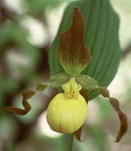Cypripedium calceolus (L.) var. pubescens (Willd.) Correll
Large yellow lady's-slipper
The specific epithet calceolus is the Latin meaning "little
shoe," in reference to the slipper-like shape of the labellum. The
varietal name pubescens is the Latin meaning "downy" or
"hairy," in reference to the hairy nature of the plant.



DESCRIPTION: Plant
arising from a rhizome with a fascicle of numerous fibrous roots, 15-80
cm high; several to many stems may arise from the same rhizome. Leaves
3-5 (-6), ovate to ovate-lanceolate, plicate, 5-20 cm long and 4-10 cm wide;
pubescent. Flowers 1-2, each subtended by a ovate to ovate-lanceolate,
green foliaceous bract 4-10 cm long by 1-4 cm wide. Sepals apparently
two (the result of the fusion of the two lateral sepals behind the labellum),
green streaked with brown to brown (but highly variable in coloration);
dorsal sepal ovate, 3-7 cm long and 1-3.5 cm wide; lateral sepals united
and similar to dorsal sepal but typically spirally twisted, tip typically
divided. Petals colored as sepals, linear-lanceolate, 4-9.5 cm long
and typically less than 1 cm wide; petals usually spirally twisted. Labellum
pouch-shaped, inflated, obovate, 1.5-6 cm long, opening above with inrolled
edges; yellow streaked or spotted inside with madder-purple.
SIMILAR SPECIES: Cypripedium calceolus var. pubescens
would most likely be confused with C. calceolus
var. parviflorum. C. calceolus var. parviflorum
is distinguished primarily by the smaller labellum and darker sepals.
HABITAT: In the southern part of Wisconsin, this variety is typically
found growing in moist, rich deciduous woods. Further north it occurs in
similar habitat but may also occur in boggy or swampy areas (where it also
occasionally found in the south). The plant is rarely found in clayey soils,
and shows a distinct preference for areas of limestone. In Door County,
where this taxon is particularly numerous, it often grows in limestone gravel
along roadsides.
FLOWERING DATES: May 10-July 15.
POLLINATION: According to Stoutamire
(1967), plants are pollinated by a number of different species of small
bees, primarily adrenid and halictid bees. The plants are also visited and
sometimes pollinated by a variety of Diptera.
WI DISTRIBUTION:  U.S. DISTRIBUTION:
U.S. DISTRIBUTION:
Go directly to Wisconsin herbarium records.
Return
to the main LIST of the Orchids of Wisconsin.
Return to the main KEY to the Orchids of
Wisconsin.



 U.S. DISTRIBUTION:
U.S. DISTRIBUTION: